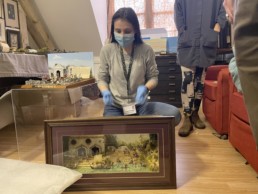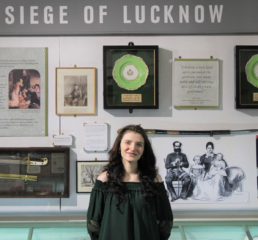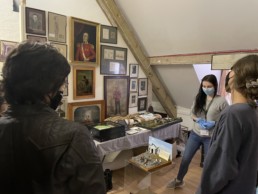1857 AND THE SIEGE OF LUCKNOW
CURATED BY ISABELLA HOGAN AT BODMIN KEEP
1857 and the siege of Lucknow were a turning point for British colonialism in India. Up until this point, the British East India Company, a trading company, had taken control of large parts of the Indian subcontinent. Throughout this process, they relied upon alliances with local Indian rulers as well as an army of Indian soldiers. These men were known as sepoys.
In 1857, large groups of sepoys rebelled. They were supported by Indian civilians and nobles across northern India, who set about besieging and reclaiming various cities under British rule.
In the city of Lucknow around 3,000 British supporters were held under siege for 148 days. This exhibition explores the reasons behind the rebellion and examines what life was like for the British and Indian defenders of Lucknow.
CURATORIAL TASK: REFLECTIVE WRITING
A Decolonial Backbone: 1857 and the Siege of Lucknow
Decolonising a collection is a challenging but rewarding process, as is curating an exhibition. ‘1857 and the Siege of Lucknow’ was my first time doing either process. It was even more of a challenge because I knew very little about the British Empire in India. However, now I can confidently recount that 1857 was a turning point in British colonialism in India, when groups of Indian soldiers and civilians, across northern India, rose up against the rule of the British East India Company.
How did the project unfold?
My first few months were spent learning how the British presence in India began, how this escalated into colonial control, as well as what happened in 1857, why the rebellions started, and what implications it had for colonialism. The Citizen Curators of 2019/20 had already started this research which gave me a springboard to focus on the experiences of British and Indian men, women, and children who experienced the rebellions. By May 2021, I had a good grasp of the context, and I began to draft information panels for a non-specialist audience who like myself may never have studied or heard of 1857 before coming to the Keep. The next few months were a steep learning curve. Having come to this project with too little knowledge, I now found that I had the opposite problem: there was so much fascinating information to communicate: the history of the British East India Company and its armies, the rising tensons in British-Indian relations due to Christian missionaries, the treatment of mixed race children, the religious, economic and political reasons behind the rebellions, the events at Lucknow and Cawnpore, the historic conflicts between Sikhs, Muslims and Hindus which made the rebellion in the Punjab vastly different to that in Oudh…. On top of this, I was learning how to budget, timetable for the installation, manage the workload of volunteers, and create a digital exhibition including captioned-video content and alt-text images.
Encountering critiques
Perhaps the greatest skill I learnt during this decolonisation project was how to deal with critique. I encountered my first critique when I presented our redisplay plans as part of the National Army Museum’s Regimental Curators’ course. A commenter suggested that by redisplaying the museum we would lose the beliefs of contemporaries, condemn people in the past for failing to adhere to today’s standards, and end up explaining history as we would like it to be, not as it was. This message stayed with me for a while as I tried to figure out how I would respond to it had this been a face-to-face discussion. What are the contemporary beliefs that this person was referring to, whose beliefs were they, and how exactly would they want them to be ‘preserved’? Perhaps they were referring to my critique of the term ‘mutiny’ which I argued concentrated on the British feeling of betrayal as Indian soldiers rebelled against their British or European officers. In contrast, in India, the terms ‘revolt or ‘uprising’ are common and these terms seem, at least to me, to be more neutral or, at the very least, more factual. I understand how the word ‘mutiny’ can be applied to an episode of soldiers rebelling against their commanding officers, however the rebellions of 1857 did not just include soldiers but including Indian nobles and civilians too. As a result, I chose to remove the large vinyl title ‘Indian Mutiny’ from the top of the display boards. But it would be a mistake to view this change as a ‘rewriting of history’ or as ‘losing the views of contemporaries’ for I have never denied that the term ‘mutiny’ was used. Instead, we have a dedicated panel in which we explain the various names for the rebellions used in 1857 and in present day. In this section there is also a voting box where people can tell us what they would call 1857: a rebellion, a mutiny, or a war of independence as it may have been for the rebels themselves. In this way we have not written history as we would like it to be rather, we have ‘preserved’ the beliefs of many more contemporaries than just the ruling British. We have cast a critical eye over our language without changing the language of the past.
What role does judgement play?
Now the challenge about ‘condemning people for not adhering to today’s standards’ is one of the toughest to rebut. However, I think it is possible for interpretation to be guided by today’s moral compass and still present an accurate explanation of history as it happened. The problem is that we have created national heroes, institutions, or events that we celebrate as a source of pride. In doing so we have reduced the past into a generalised ‘good’ or ‘bad’ category. When decolonisation calls for a closer investigation of these pride-generators, we feel threatened and reply with ‘he is a man of his time’. Perhaps. But he is not a man of our time. People in the past did live by different standards but we want to create a better future than what came before. That means we have to, to some extent, ‘judge the past by today’s standards’. Once again, that does not mean that we ‘re-write history as we would like it to be’ or write people out of history. Rather it is this desire to move forwards in society that encourages us to cast a critical eye over our presentation of historic events and historic peoples. We need to dissect the institutions, events and people that are sources of national pride. We need to present an event or an individual in all their complex forms, heroes, and villains, the good and the bad. It is only by broadening out the focus, by decolonising and talking about the uncomfortable truths that we get an accurate understanding of the past.
Finding my backbone
I firmly believe that our redisplay project at Bodmin Keep has given visitors a much richer understanding of the challenge to British colonial rule in India in 1857. Our voting box is a popular interactive that needs to be reset weekly. This project has shown us that there is great social and interpretative value in decolonising our collections and there is a demand for such projects. From my own perspective, working on this exhibition has given me the confidence to engage with decolonisation projects. I have had the opportunity to develop my own opinions and to start my career as I mean to go on: using a decolonial lens as a backbone for any interpretation, even if it means upsetting the status quo.


